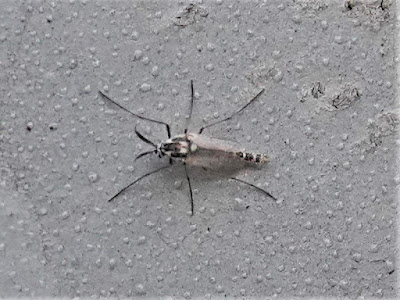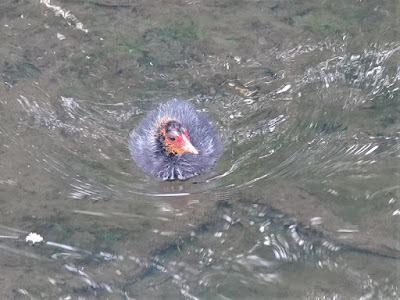9.0°C > 14.0°C: Mainly clear with thin high cloud. Some areas of low cloud visible in the distance. Moderate north-westerly breeze. Very good visibility.
Sunrise: 05:28 BST
* = a species photographed today
Priorslee Balancing Lake: 05:00 – 06:20 // 07:15 – 09:45
* = a species photographed today
Priorslee Balancing Lake: 05:00 – 06:20 // 07:15 – 09:45
(98th visit of the year)
Bird notes:
- the resident Canada Geese now have six goslings.
- the resident Greylag Geese now have five goslings.
- *juvenile Long-tailed Tits seen.
- neither and of the Sedge Warblers or the Lesser Whitethroat was heard.
- the long-term Common Whitethroat at the West end again sang very intermittently. No others seen or heard.
- I may, or may not, have caught a snatch of Garden Warbler song: it was very brief, if at all.
- juvenile Starlings were head begging from nests.
Counts of birds noted flying over:
- 2 Canada Geese: a pair outbound
- 4 Wood Pigeons
- 4 Lesser Black-backed Gulls
- 20 Jackdaws
- 1 Rook
Hirundines etc. noted:
- 2 Barn Swallows
Warblers noted (the figure in brackets relates to birds heard singing):
- 1 (1) Cetti's Warbler
- 14 (12) Chiffchaffs
- 10 (10) Reed Warblers
- 11 (10) Blackcaps
- 1 (1) Garden Warbler?: see notes
- 1 (1) Common Whitethroat
'nominal' warbler:
- 2 (2) Goldcrests
Counts from the lake area:
- 10 + 6 (1 brood) Canada Geese: four additional pairs!
- 2 + 5 (1 brood) Greylag Geese
- 2 Mute Swans
- 6 (5♂) Mallard: also 1 (1♂) on the lower pool
- 3 Moorhens
- 21 Coots
- 5 Great Crested Grebes
- 1 Black-headed Gull: adult, very briefly
- 1 Herring Gull: first summer, briefly
- 1 Lesser Black-backed Gulls: adult, briefly
Seen on the street lamps poles pre-dawn:
Moths:
- *1 pug, probably a Common Pug Eupithecia vulgata
- *1 pug, probably a Common Pug Eupithecia vulgata
Bees, wasps etc.
- *1 ichneumon, probably Ophion obscuratus
- *1 ichneumon, probably Ophion obscuratus
Other flies:
- *1 male plumed midge with marked wings
- *1 midge with patterned thorax
- *1 caddisfly, perhaps Tinodes waeneri
- *1 male plumed midge with marked wings
- *1 midge with patterned thorax
- *1 caddisfly, perhaps Tinodes waeneri
Beetle:
- *1 unidentified ground beetle
- *1 unidentified ground beetle
Spiders:
- *2 Stout Sac Spiders Clubiona sp.
Noted later:
- *2 Stout Sac Spiders Clubiona sp.
Noted later:
Moths:
- Common Nettle-tap Anthophila fabriciana
- Common Nettle-tap Anthophila fabriciana
Bees, wasps etc.
- *Tawny Mining Bee Andrena fulva
- *Orange-tailed Mining Bee Andrena haemorrhoa [Early Mining Bee]
- Common Carder Bee Bombus pascuorum
- *Flavous Nomad Bee Nomada flava
- *another smaller nomad bee
- Red Mason Bee Osmia bicornis
- *Tawny Mining Bee Andrena fulva
- *Orange-tailed Mining Bee Andrena haemorrhoa [Early Mining Bee]
- Common Carder Bee Bombus pascuorum
- *Flavous Nomad Bee Nomada flava
- *another smaller nomad bee
- Red Mason Bee Osmia bicornis
Hoverflies:
- *Spring Epistrophe Epistrophe elegans [Spring Smoothtail]
- Tapered Dronefly Eristalis pertinax
- *Tiger Hoverfly Helophilus pendulus
- *Blotch-winged Hoverfly Leucozona lucorum [Blotch-winged Whitebelt]
- *Chequered Hoverfly Melanostoma scalare [Long-winged Duskyface]
- Grey-spotted Boxer Platycheirus albimanus [Grey-spotted Sedgesitter or White-footed Hoverfly]
- *Syrphus sp. S. ribesii / S. vitripennis
- *Spring Epistrophe Epistrophe elegans [Spring Smoothtail]
- Tapered Dronefly Eristalis pertinax
- *Tiger Hoverfly Helophilus pendulus
- *Blotch-winged Hoverfly Leucozona lucorum [Blotch-winged Whitebelt]
- *Chequered Hoverfly Melanostoma scalare [Long-winged Duskyface]
- Grey-spotted Boxer Platycheirus albimanus [Grey-spotted Sedgesitter or White-footed Hoverfly]
- *Syrphus sp. S. ribesii / S. vitripennis
Dragon-/damsel-flies
- *Large Red Damselfly Pyrrhosoma nymphula
- *Large Red Damselfly Pyrrhosoma nymphula
Other flies:
- *Yellow Dung Fly Scathophaga stercoraria
- caddisfly, perhaps Tinodes waeneri
- *Yellow Dung Fly Scathophaga stercoraria
- caddisfly, perhaps Tinodes waeneri
Bugs:
- *Red-and-Black Froghopper Cercopis vulnerata
- Dock Bug Coreus marginatus
- *Red-and-Black Froghopper Cercopis vulnerata
- Dock Bug Coreus marginatus
Beetles:
- Alder Leaf Beetle Agelastica alni
- 7 Spot Ladybird Coccinella 7-punctata
- *14 Spot Ladybird Propylea quattuordecimpunctata
- Alder Leaf Beetle Agelastica alni
- 7 Spot Ladybird Coccinella 7-punctata
- *14 Spot Ladybird Propylea quattuordecimpunctata
Molluscs:
- Kentish Snail Monacha cantiana
- Kentish Snail Monacha cantiana
Plants / Flowers new for the year
- *Beaked Hawk's-beard Crepis vesicaria
- *Wood Avens Geum urbanum
- *Red Clover Trifolium pratense
- *Rowan Sorbus aucupana
- *Guelder Rose Viburnum opulus [aka dogberry; water elder; cramp bark; snowball tree; European cranberry bush]
- *Beaked Hawk's-beard Crepis vesicaria
- *Wood Avens Geum urbanum
- *Red Clover Trifolium pratense
- *Rowan Sorbus aucupana
- *Guelder Rose Viburnum opulus [aka dogberry; water elder; cramp bark; snowball tree; European cranberry bush]
Mainly clear at sunrise time.
A juvenile Long-tailed Tit begging to be fed.
Here, on the right, with an adult on the left. Note their different head markings.
The council failed to do anything about the street light that doesn't but replaced a perfectly functioning light with one with a pole at least 20 feet high. So I was not able to obtain a very clear image of this pug moth near the top. I think it is a Common Pug Eupithecia vulgata , the white marks toward the rear of the wing being a useful feature.
A stunning insect: it is a Tawny Mining Bee Andrena fulva.
Another mining bee: this is an Orange-tailed Mining Bee Andrena haemorrhoa.
This is probably a Flavous Nomad Bee Nomada flava. This group of bees are identified by the position and extent of brown markings at the centre of the abdomen where the yellow bands meet. These markings are almost impossible to see when the wings are folded. Flavous Nomad Bee is the most common in our area.
I noted at least six different individuals.
This seemed to be a smaller species of Nomad Bee.
Also on a street lamp pole was this ichneumon, probably Ophion obscuratus. The "wasp waist" shows well from this angle.
A Spring Epistrophe hoverfly Epistrophe elegans [Spring Smoothtail].
My first Tiger Hoverfly Helophilus pendulus of the year.
Another very distinctive hoverfly is Blotch-winged Hoverfly Leucozona lucorum. Obsidentify calls it Blotch-winged Whitebelt, not unreasonably. Here feeding on Cow Parsley Anthriscus sylvestris.
A female Chequered Hoverfly Melanostoma scalare showing her triangular yellow marking. I must try and find a male to show his rectangular marks.
A hoverfly hovering. It is one of the 'difficult pair' Syrphus ribesii / S. vitripennis.
A Large Red Damselfly Pyrrhosoma nymphula : always the first damsel- / dragon-fly I see each year.
I am used to seeing plumed midges on the street lamp poles. Not individuals with a mark in each wing. Species unidentified.
A midge without plumes antennae so perhaps a female. This species with a banded abdomen and patterned thorax. Also unidentified.
One of my favourite flies: a Yellow Dung Fly Scathophaga stercoraria.
On a street lamp pole was this caddisfly which Obsidentify was 100% sure is Tinodes waeneri. I know very little about caddis flies so I have to assume it is correct. There were three more, all apparently this species, on the boxing ring later.
Successfully hiding partially inside a street lamp was this unidentified ground beetle.
My first Red-and-Black Froghopper Cercopis vulnerata of the year.
A 14 Spot Ladybird Propylea quattuordecimpunctata. Not so much 'spots' as marks: and not always 14 either.
One of two Stout Sac Spider Clubiona sp. I noted.
This may be Beaked Hawk's-beard Crepis vesicaria. The various hawk-things are difficult to separate and it depended upon the angle I took photos as to the identification from Obsidentify. This seemed the most frequent result.
An unobtrusive and delicate yellow flower. It is Wood Avens Geum urbanum.
Just appearing is the first flower of Red Clover Trifolium pratense. It will be several weeks before the White Clover T. repens flowers
Either deliberately or accidentally some of the grassy area alongside the football field has not been mown. A good crop of Dandelion Taraxacum officinale aggregate. clocks!
The leaves on this tree help identify the flower as from a Rowan Sorbus aucupana.
A very distinctive flower is Guelder Rose Viburnum opulus, it has many other vernacular names: dogberry; water elder; cramp bark; snowball tree; European cranberry bush.
(Ed Wilson)
------------------------------------------------------------------------------------------------------
In the Priorslee Avenue tunnel:
Nothing of note
The Flash: 06:25 – 07:10
(Ed Wilson)
------------------------------------------------------------------------------------------------------
The Flash: 06:25 – 07:10
(100th visit of the year)
Bird notes:
- six Mute Swans present including what appeared to be the resident adults together and with no cygnets.
- a Willow Warbler noted singing but now on the West side of the water. Same bird relocated? A new arrival?.
- a fly-over Lesser Redpoll: an unusual date here.
Bird(s) noted flying over here:
- 1 Jackdaw
- 1 Lesser Redpoll
Warblers noted (the figure in brackets relates to birds heard singing):
- 1 (1) Willow Warbler
- 6 (6) Chiffchaffs
- 5 (5) Blackcaps
'nominal' warbler:
- 1 (1) Goldcrest
Noted on / around the water:
- 10 Canada Geese
- 2 Greylag Geese
- 6 Mute Swans
- 9 (7♂) Mallard
- 5 Moorhens
- *19 + 2 (2? broods) Coots
- 2 Great Crested Grebes
Noted elsewhere around The Flash:
Moths:
- *Common Pug Eupithecia vulgata
- *Common Pug Eupithecia vulgata
Beetles:
- Alder Leaf Beetle Agelastica alni
- Alder Leaf Beetle Agelastica alni
Spiders:
- Long-jawed Orb-web Spider Tetragnatha sp.
- *spider, presumed Metellina merianae
- Long-jawed Orb-web Spider Tetragnatha sp.
- *spider, presumed Metellina merianae
A puzzle. An adult Coot feeding a well-grown juvenile with white breast.
The same adult Coot was also feeding this small juvenile still with bare red skin on the face. I would be most surprised if the Coots could have had two broods already yet I doubt juveniles from the same brood could develop so differently. So?
A female Blackbird not so much carrying nesting material but carrying most of a nest!
On a street lamp pole in squirrel alley was this Common Pug moth Eupithecia vulgata
Also on a street lamp pole was this spider which Obsidentify was 100% sure is Metellina merianae.
(Ed Wilson)
------------------------------------------------------------------------------------------------------
Sightings from previous years
2012
Priorslee Lake
1 Common Sandpiper
(John Isherwood)
Nedge Hill
10 Wheatear
(John Isherwood)
2008
Nedge Hill
5 Wheatear
Yellow Wagtail
(Ed Wilson)
2006
Priorslee Lake
Hobby
1 Common Sandpiper
1 Cuckoo
2 Ruddy Ducks
(Ed Wilson / Martin Adlam)
Nedge Hill
1 Ring Ouzel
4 Wheatear
(Arthur Harper)


































